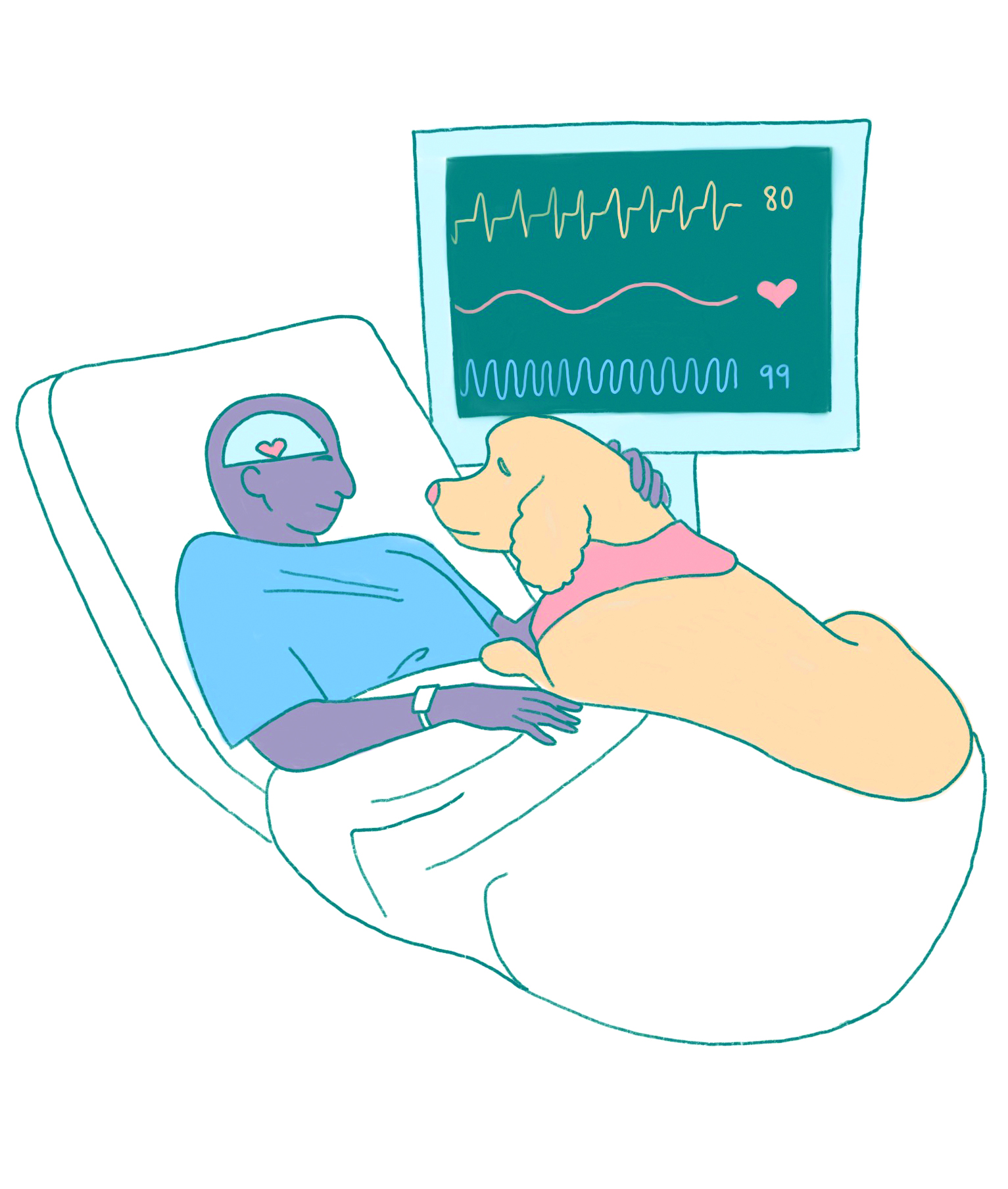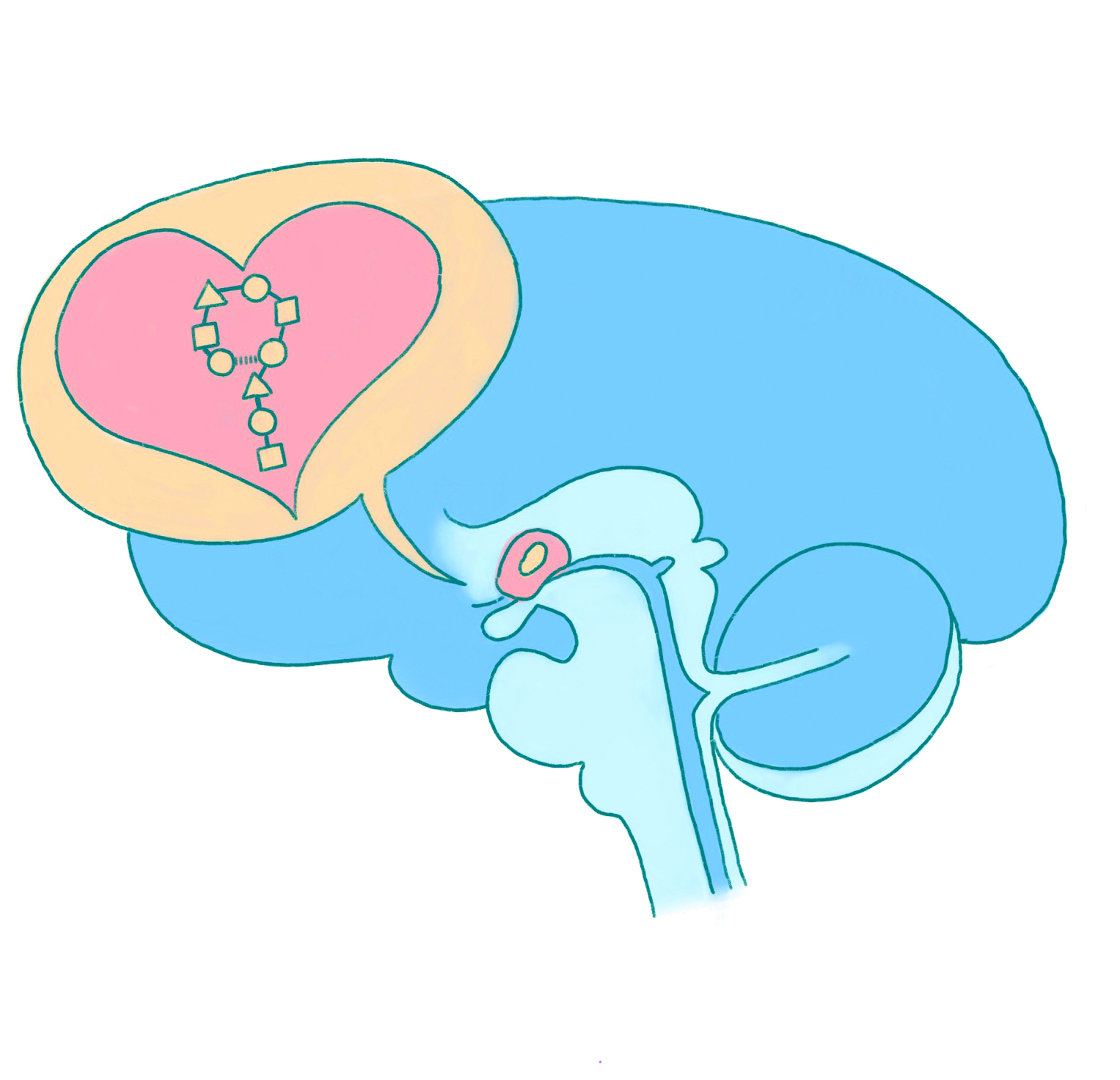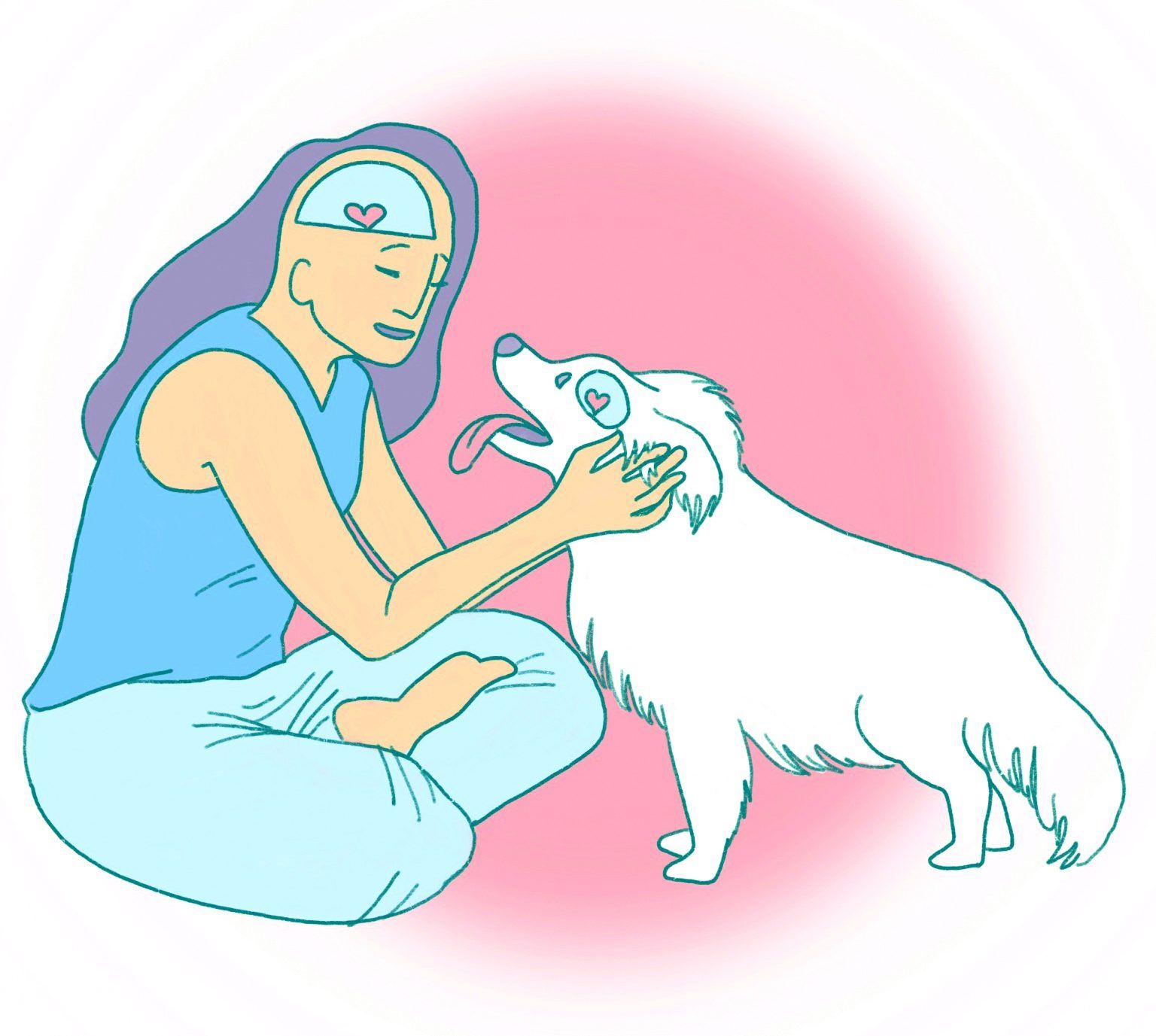With the weight of exams, papers, and deadlines on students’ shoulders, it’s not unusual for colleges and universities to promote programs that assist students in managing their stress levels. At the University of Washington, College Dogs events are popular among students, where certified therapy dogs and their handlers visit campus with the goal of relieving stress in the form of cuddles and wagging tails [1]. This generates an interesting question: How are dogs and other animals able to comfort humans in this unique way? Research in the last several decades provides evidence of several health benefits that animals can bring to humans. Spending time petting and interacting with animals can lower blood pressure and reduce heart rate, stress, fear, and anxiety. While animal interaction is considered to benefit humans through multiple neurochemical systems, the oxytocin system is speculated to play a major role in its many positive effects [2].
Oxytocin (OT) is a peptide hormone produced by the hypothalamus. Following production, these neuropeptides are released into the circulatory system and are captured in a network of nerves [3]. Sensory stimulation then acts to influence the release of OT through actions such as touch, stroking, labor, and breastfeeding. While OT is best known for its role in childbirth and breastfeeding, over time it has become implicated in the modulation of many physiological, psychological, and behavioral functions [4]. For example, OT has been shown to have stress-relieving and anxiety-reducing effects. Increased levels of OT reduce the amount of cortisol (a stress hormone) released in response to social stressors [5]. A characteristic behavioral effect similar to that of anxiety-reducing drugs was observed following the injection of OT into male rats [6]. OT also plays a role in the modulation of physiological functions, such as through the regulation of blood pressure and heart rate. Following the injection of OT into the cerebrospinal fluid of male and female rats, researchers observed a decrease in blood pressure and heart rate [7][8]. As rats generally serve as a good model species for humans, these findings help support the conclusion that OT has a positive influence on human health.
The overlapping effects of animal interaction on humans and the behavioral effects of OT suggest that OT plays a role in the bond between humans and animals. In one study, researchers observed significantly increased OT levels in a group of female dog owners following a three-minute session of sensory stimulation that included petting and talking to their dogs [9]. This suggests that OT plays a role in human-animal interactions. In a separate study, researchers recorded the changes in OT levels in both humans and dogs after the humans stroked the dogs [10]. Interestingly, they found that the OT levels of both subject groups nearly doubled following this interaction. This research highlights the idea that beneficial interactions between two species can lead to a mutualistic relationship, thus revealing a physiological basis for the role of a dog as a companion animal for humans [10].

Another study further examined the changes in OT levels in both men and women after they came home from work and interacted with their dogs [11]. To eliminate the possibility that OT levels may be impacted by simply returning home, researchers established a control condition where individuals arrived home and quietly read by themselves. They found that there was a significant increase in OT levels when the women interacted with their dogs. On the other hand, OT levels in men decreased following both conditions. It is unclear as to why this result occurred, but it seems to suggest that men and women may have different hormonal responses to animal interaction. However, OT is only one measurable biomarker and may be sex-specific to women. Thus, these results do not necessarily suggest that dogs offer less health benefits to men [11]. The study’s researchers speculated that these findings may be due to the influence of estrogen on OT levels in women. Estrogen is a strong stimulus for OT production and tends to be released in greater quantities in women than in men [11]. It is important to note that while these studies focus specifically on the influence of dogs on OT levels in humans, we can speculate that the findings from studies on humans and dogs can be generalized to incorporate other human- animal relationships [12].
With the many benefits that animal interactions offer, it’s no wonder that the role of service animals has grown in recent decades. Service animals can help humans with a wide variety of conditions and disabilities, thus allowing people to live fuller and more independent lives. This can range from physical disabilities, such as visual impairment, to psychological conditions, like autism spectrum disorders and post-traumatic stress disorder [12]. However, there is potential for the role of service animals to be expanded even further. In the last decade, researchers have explored the possibility of dog walking as a potential means to motivate physical activity in owners, which may play a role in reducing the risk of conditions linked to sedentary lifestyles [13]. Researchers are also examining how dogs may play a role in seizure detection due to their potential ability to predict when seizures will occur [14]. Overall, by studying the effects of OT on human-animal interactions, we can gain a better understanding of the benefits of a close relationship with animals and further expand the use of animal therapy as a way to improve human lives.

References
- College Dogs. (n.d.). Retrieved January 27, 2018, from http://www.collegedogs.org/
- Beetz, A., Uvn ä s-Moberg, K., Julius, H., & Kotrschal, K. (2012). Psychosocial and Psychophysiological Effects of Human-Animal Interactions: The Possible Role of Oxytocin. Frontiers in Psychology , 3 , 234. doi:10.3389/fpsyg.2012.00234
- Landgraf, R. & Neumann, I.D. (2004). Vasopressin and Oxytocin Release within the Brain: A Dynamic Concept of Multiple and Variable Modes of Neuropeptide Communication. Frontiers in Neuroendocrinology, 25 (3-4), 150-176. doi:10.1016/j.yfrne.2004.05.001
- Magon, N., & Kalra, S. (2011). The Orgasmic History of Oxytocin: Love, Lust, and Labor. Indian Journal of Endocrinology and Metabolism, 15 (7), 156. doi:10.4103/2230-8210.84851
- Heinrichs, M., Baumgartner, T., Kirschbaum, C., & Ehlert, U. (2003). Social Support and Oxytocin Interact to Suppress Cortisol and Subjective Responses to Psychosocial Stress. Biological Psychiatry, 54 (12), 1389-1398. doi:10.1016/s0006-3223(03)00465-7
- Uvnäs-Moberg, K., Ahlenius, S., Hillegaart, V., & Alster, P. (1994). High Doses of Oxytocin Cause Sedation and Low Doses Cause an Anxiolytic-like Effect in Male Rats. Pharmacology Biochemistry and Behavior, 49 (1), 101-106. doi:10.1016/0091-3057(94)90462-6
- Petersson, M., Alster, P., Lundeberg, T., & Uvnäs-Moberg, K. (1996). Oxytocin Causes a Long-Term Decrease of Blood Pressure in Female and Male Rats. Physiology & Behavior, 60 (5), 1311-1315. doi:10.1016/s0031-9384(96)00261-2
- Rogers, R. C., & Hermann, G. E. (1985). Dorsal Medullary Oxytocin, Vasopressin, Oxytocin Antagonist, and TRH Effects on Gastric Acid Secretion and Heart Rate. Peptides, 6 (6), 1143-1148. doi:10.1016/0196-9781(85)90441-3
- Handlin, L., Hydbring-Sandberg, E., Nilsson, A., Ejdebäck, M., Jansson, A., & Uvnäs-Moberg, K. (2011). Short-Term Interaction between Dogs and Their Owners: Effects on Oxytocin, Cortisol, Insulin and Heart Rate—An Exploratory Study. Anthrozoös, 24 (3), 301-315. doi:10.2752/175303711×13045914865385
- Odendaal, J., & Meintjes, R. (2003). Neurophysiological Correlates of Affiliative Behaviour between Humans and Dogs. The Veterinary Journal, 165 (3), 296-301. doi:10.1016/s1090-0233(02)00237-x
- Miller, S. C., Kennedy, C. C., Devoe, D. C., Hickey, M., Nelson, T., & Kogan, L. (2009). An Examination of Changes in Oxytocin Levels in Men and Women Before and After Interaction With a Bonded Dog. Anthrozoös, 22 (1), 31-42. doi:10.2752/175303708×390455
- Mccune, S., Kruger, K. A., Griffin, J. A., Esposito, L., Freund, L. S., Hurley, K. J., & Bures, R. (2014). Evolution of Research into the Mutual Benefits of Human-Animal Interaction. Animal Frontiers, 4 (3), 49-58. doi:10.2527/af.2014-0022
- McCune, S. K., Beck, A. M., & Johnson, R. A. (2011). The Health Benefits of Dog Walking for Pets and People: Evidence and Case Studies . Purdue University Press.
- Brown, S. W., & Goldstein, L. H. (2011). Can seizure-alert dogs predict seizures? Epilepsy Research, 97 (3), 236-242. doi:10.1016/j.eplepsyres.2011.10.019
